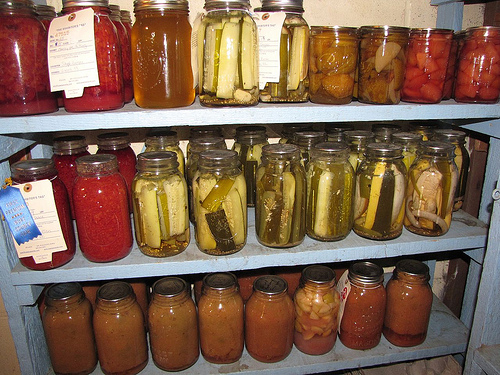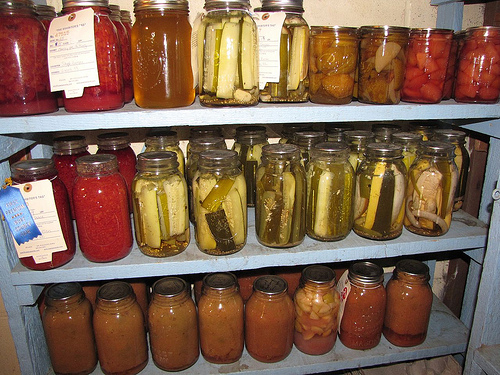 In a pickle: Canning all these jars used a lot of energy, but storing them doesn’t.Photos: Steph LarsenThis year’s harvest has been a good one, and I’ve been doing my best to preserve as much of it as I can to enjoy over the winter. To do this, I rely heavily on my new 22-quart pressure canner, our small freezer, and a food dehydrator. In anticipation of the whole lamb that will soon join the frozen green beans, peppers and cherries, we’ve ordered another, bigger freezer that we’ll rotate in and out of use.
In a pickle: Canning all these jars used a lot of energy, but storing them doesn’t.Photos: Steph LarsenThis year’s harvest has been a good one, and I’ve been doing my best to preserve as much of it as I can to enjoy over the winter. To do this, I rely heavily on my new 22-quart pressure canner, our small freezer, and a food dehydrator. In anticipation of the whole lamb that will soon join the frozen green beans, peppers and cherries, we’ve ordered another, bigger freezer that we’ll rotate in and out of use.
All of these food preservation methods have one painful thing in common: they use substantial amounts of electricity.
To be fair, we’re reducing our carbon footprint by growing as much food as we can ourselves, instead of driving to the far-away grocery store to buy food that’s mostly been trucked in. And when I preserve food, I try to be as efficient as possible — canning multiple batches so the water is still hot, keeping my freezer jam-packed. But I’d still like to conserve more energy when preserving food. So I started digging … metaphorically, at least for the time being.
Shelf space is abundant in my house, so canning has been my preservation method of choice. Early in the season, I realized that my black water-bath canner — the ubiquitous one that everyone’s mother seems to have — requires about 14 quarts of water to cover seven quart jars. That much liquid takes an age to boil. So I switched to a same-sized pressure canner that uses only three quarts of water and takes much less time on the stove.
Unfortunately, there’s little else I can think of to decrease my energy use while canning, aside from pre-heating the water in the sun. Canning involves heating up food to specific temperatures for precise amounts of time to kill bacteria. Skimping anywhere can lead to potentially fatal botulism, and I’d like to be alive for next year’s harvest. The positive thing about this method is that once canned, my pickles and tomatoes can sit on the shelf for several years and not require another watt.
Unlike the freezer. Although we bought an EnergyStar chest freezer, it will still use 354 kilowatt hours per year. To put that in perspective, it takes a ton of Wyoming coal burned in one of Nebraska’s power plants to generate an average of 2,500 kilowatt hours of electricity, so running our freezer would take at least 285 pounds of coal. For the same amount of electricity, I could run a 2,500-watt electric burner on my stove for over 140 hours. Suddenly canning doesn’t seem like such an energy hog.
 Good gourds: Squash from the garden don’t need to be refrigerated as log as they stay cool and dry.Another way I’ve preserved food is drying. I recently acquired an electric food dehydrator made in the early 1990s. I don’t know how many watts it used, but it was plugged in for 24 hours to dry a quart-sized bag of apple slices. That seems like a lot. So I’m looking forward this winter to researching the best design for a solar food dehydrator that wouldn’t be too hard for a novice to build herself. Any suggestions?
Good gourds: Squash from the garden don’t need to be refrigerated as log as they stay cool and dry.Another way I’ve preserved food is drying. I recently acquired an electric food dehydrator made in the early 1990s. I don’t know how many watts it used, but it was plugged in for 24 hours to dry a quart-sized bag of apple slices. That seems like a lot. So I’m looking forward this winter to researching the best design for a solar food dehydrator that wouldn’t be too hard for a novice to build herself. Any suggestions?
Not everything I harvested needs active preserving: apples and winter squash just need cool, relatively dry conditions to keep for several months. Back when we were still house-hunting, we looked at several places with workable root cellars, which I really liked. Alas, we don’t have one here.
However, our house was built in the early 1950s, and it has a few throwbacks to the era before electric refrigeration. There is a small closet in the basement under the front stoop that has wide shelves, a dirt floor, and three walls adjacent to the soil outside. I might try to store some butternut squash in there to see how they do. Short of digging a new root cellar, I’d like to build some kind of insulated storage room in the basement that will use the natural coolness of the exterior walls and draw in cold night air as the weather turns to maintain ideal storage conditions longer.
I have a feeling I’ve only just begun to scratch the surface of low-tech, energy-conserving ways to keep my garden produce edible well into 2011. Do you, dear readers, have tips, tricks, and innovations that have helped you through some long winters? My electricity bill and my carbon conscience thank you in advance for sharing them.



